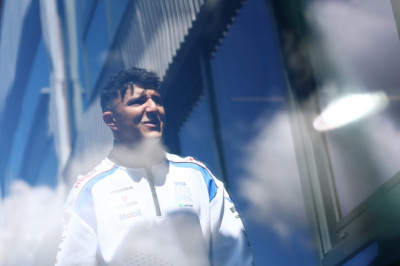
Race (and win?) on Sunday, sell on Monday. That’s the old saying, right? Turns out Ford flipped the script and its latest race car’s aerodynamics actually came from its street car.
At the the launch of the 2025 Ford Mustang GTD Chief Program Engineer Greg Goodall and Design Manager Anthony Colard told The Drive the Mustang GT3 race car was set to have a traditional decklid-mounted wing like other race cars. Then came the GTD and everything changed.
The design and development went Darkhorse, then GT3, and then GTD. But the last two, GT3 and GTD, were developed in tandem once the projects were underway. That is, once the GTD was green lit.
The GTD? It exists because Ford CEO Jim Farley and Bill Ford saw the Mustang GT3 and told the team, “we need to do a road-legal version of this,” Colard recalled.
Six months into developing the road car Colard said a designer came up with the idea of a swan neck design with a C-pillar mount for the rear wing for the road car, which would come to be known as the GTD. The race car was still being finalized in CAD.
Colard said the team already knew how much pressure from downforce was going to be applied to the rear wing and it was going to make mounting it on the trunk lid “a difficult task.” Mounting it via swan necks on the C-pillar instantly made things easier as the pillars are already reinforced. This is all before the use of active aerodynamics entered the chat. Once the team checked to make sure it would perform on the race car, the decision was made to harmonize the two together. It doesn’t just look cool, it’s functional both Goodall and Colard noted.
“Not only does it look cool, it can manage the loads a lot better, and hides the features better, later on, much later, we figured out the active aero and said ‘oh yeah, thank God we made this choice because it makes the active aero easier.'” Goodall said. The reason it makes the active aero easier is because all the wiring and lines can be run to the wing through the C-pillar, which is stationary unlike a trunk lid, which needs to move up and down to access the trunk.
Colard said there was a world the GTD would not have gotten active aero. It was not in the original plans. Goodall said active aero was a debate, but in the end it made the car better and faster, noting it contributed to the GTD lapping the Nürburgring in under 7 minutes.
“We would have still got under 7-minutes (referring to the ‘Ring lap time) without it, but then we were like, hey, we can get some time with the active aero, and we should just do this,” Goodall said. “It would have definitely been tighter” Goodall said, in regards to getting under the 7-minute mark at the ‘Ring without the active aero.
Without that rear wing and active aero, there’s no way the GTD would’ve shaved 5.5 seconds off its original 6:57.685 ‘Ring time to conquer the Green Hell at 6:52.072 six months after the fact.
Got a tip about aerodynamics? Shoot us a note at tips@thedrive.com
As Director of Content and Product, Joel draws on over 15 years of newsroom experience and inability to actually stop working to help ensure The Drive shapes the future of automotive media.














